Water Storage Monitoring in the Aral Sea and its Endorheic Basin from Multisatellite Data and a Hydrological Model
Abstract
:1. Introduction
2. Materials and Methods
2.1. Landsat-7 ETM+ and Landsat-8 OLI/TIRS
2.1.1. Landsat Image
2.1.2. Surface Water Mapping
2.2. Envisat and CryoSat-2
2.2.1. Altimetry Data
2.2.2. Water Level Extraction
2.3. Calibrated Hypsometric Curves
2.4. GRACE Gravimetry
2.5. Land Surface Model and Hydrological Model
2.6. Auxiliary Databases
3. Results
3.1. Water Level, Surface Area, and Volume Anomaly of the Aral SEA
3.2. Water Storage Changes in the Aral Sea and Its Endorheic Basin
3.3. Precision Evaluation
4. Discussion
4.1. Interannual Variabilities in the Water Storage Components of the Aral Sea
4.2. The Impact of Human Interventions and Climate Change on the TWS in the Aral Sea Endorheic Basin
5. Conclusions
Author Contributions
Funding
Acknowledgments
Conflicts of Interest
Appendix A
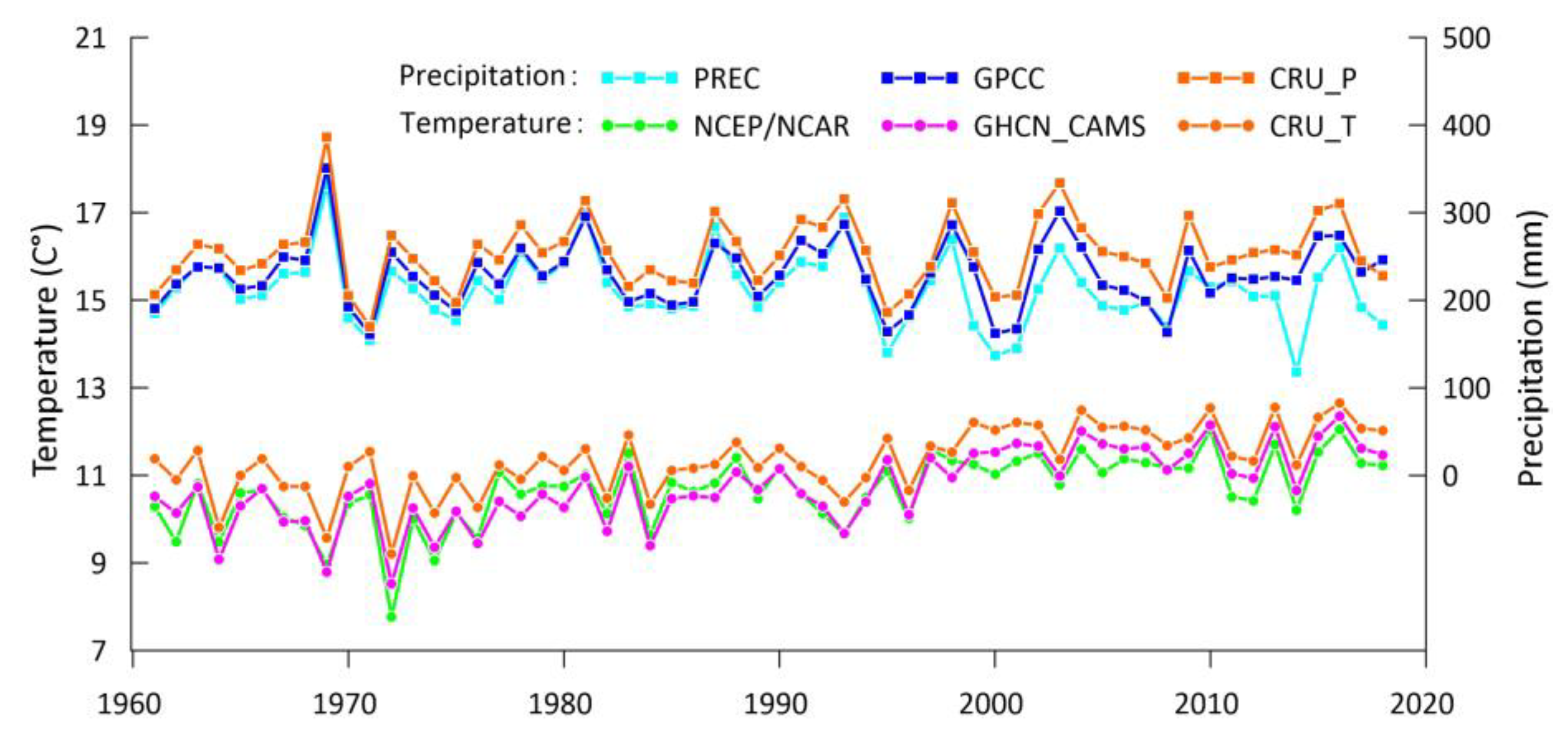
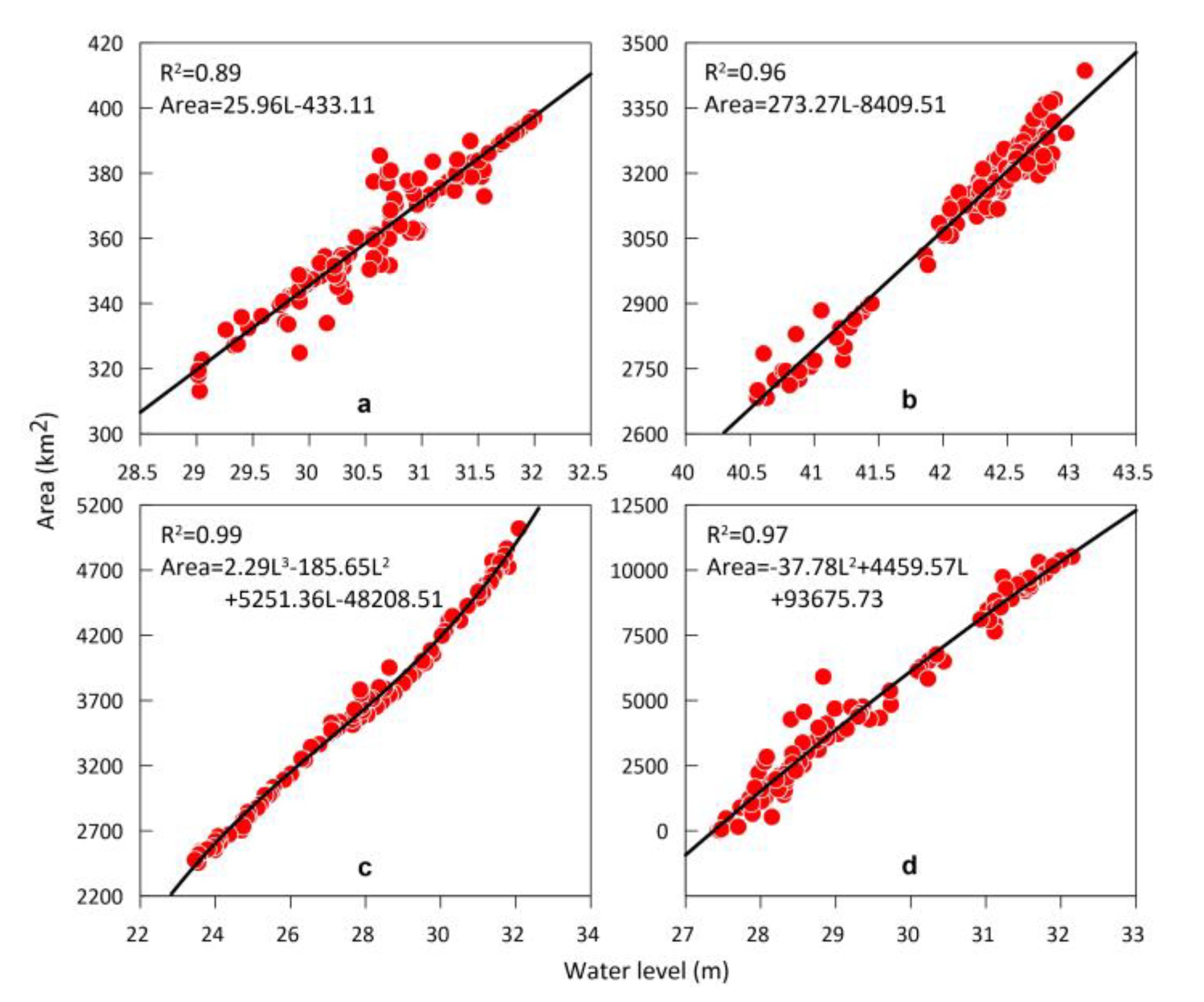

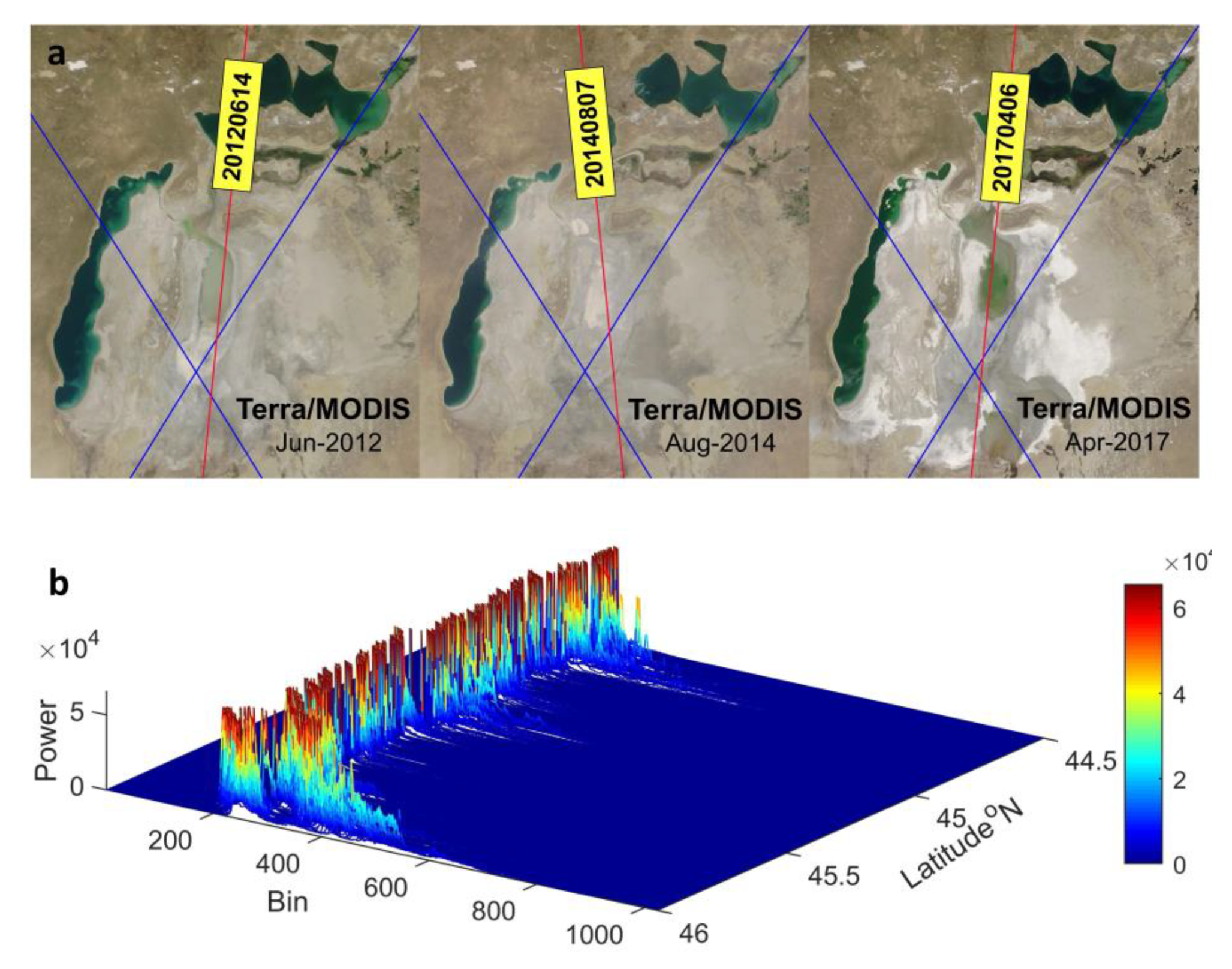
References
- Micklin, P. Desiccation of the Aral Sea, a water management disaster in the Soviet Union. Science 1988, 241, 1170–1176. [Google Scholar] [CrossRef] [PubMed] [Green Version]
- Sahagian, D.L.; Schwartz, F.W.; Jacobs, D.K. Direct anthropogenic contributions to sea level rise in the twentieth century. Nature 1994, 367, 54–57. [Google Scholar] [CrossRef]
- Micklin, P.P.; Williams, W.D. Climatic and Hydrologic Changes Around the Aral Sea. In The Aral Sea Basin; Springer: Berlin/Heidelberg, Germany, 1996; Volume 12. [Google Scholar]
- Punkari, M.; Droogers, P.; Immerzeel, W.; Korhonen, N.; Lutz, A.; Venäläinen, A. Climate Change and Sustainable Water Management in Central Asia. Available online: https://www.adb.org/publications/climate-change-and-sustainable-water-management-central-asia (accessed on 14 December 2019).
- Micklin, P. The past, present, and future Aral Sea. Lakes Reserv. Res. Manag. 2010, 15, 193–213. [Google Scholar] [CrossRef]
- Belyaev, A.V. Water Balance and Water Resources of the Aral Sea Basin and Its Man-Induced Changes. GeoJournal 1995, 35, 17–21. [Google Scholar] [CrossRef]
- Small, E.E.; Sloan, L.C.; Hostetler, S.; Giorgi, F. Simulating the water balance of the Aral Sea with a coupled regional climate-lake model. J. Geophys. Res. 1999, 104, 6583–6602. [Google Scholar] [CrossRef]
- Deng, H.; Chen, Y. Influences of recent climate change and human activities on water storage variations in Central Asia. J. Hydrol. 2017, 544, 46–57. [Google Scholar] [CrossRef]
- Kes’, A.; Klyukanova, I. Causes of Aral Sea level variations in the past. Sov. Geogr. 1990, 31, 602–612. [Google Scholar] [CrossRef]
- Micklin, P. The Aral Sea Disaster. Annu. Rev. Earth Planet. Sci. 2007, 35, 47–72. [Google Scholar] [CrossRef] [Green Version]
- Aladin, N.V.; Plotnikov, I.S.; Potts, W. The Aral Sea desiccation and possible ways of rehabilitating and conserving its Northern part. Environmetrics 1995, 6, 17–29. [Google Scholar] [CrossRef]
- Cretaux, J.-F.; Letolle, R.; Bergé-Nguyen, M. History of Aral Sea level variability and current scientific debates. Glob. Planet. Chang. 2013, 110, 99–113. [Google Scholar] [CrossRef]
- Birkett, C.M. The contribution of TOPEX/POSEIDON to the global monitoring of climatically sensitive lakes. J. Geophys. Res. Ocean. 1995, 100, 25179–25204. [Google Scholar] [CrossRef]
- Crétaux, J.F.; Jelinski, W.; Calmant, S.; Kouraev, A.; Vuglinski, V.; Bergé-Nguyen, M.; Gennero, M.C.; Nino, F.; Abarca Del Rio, R.; Cazenave, A.; et al. SOLS: A lake database to monitor in the Near Real Time water level and storage variations from remote sensing data. Adv. Space Res. 2011, 47, 1497–1507. [Google Scholar] [CrossRef]
- Singh, A.; Seitz, F.; Schwatke, C. Inter-annual Water Storage Changes in the Aral Sea from Multi-mission Satellite Altimetry, Optical Remote Sensing, and GRACE Satellite Gravimetry. Remote Sens. Environ. 2012, 123, 187–195. [Google Scholar] [CrossRef]
- Schwatke, C.; Dettmering, D.; Bosch, W.; Seitz, F. DAHITI – an innovative approach for estimating water level time series over inland waters using multi-mission satellite altimetry. Hydrol. Earth Syst. Sci. 2015, 19, 4345–4364. [Google Scholar] [CrossRef] [Green Version]
- Kravtsova, V. The Aral Sea and coastal zone degradation: Monitoring by space images. In Proceedings of the 31st International Symposium on Remote Sensing of Environment, Saint Petersburg, Russia, 20–24 May 2005. [Google Scholar]
- Yang, X.; Wang, N.; He, J.; Hua, T.; Qie, Y. Changes in area and water volume of the Aral Sea in the arid Central Asia over the period of 1960–2018 and their causes. CATENA 2020, 191, 104566. [Google Scholar] [CrossRef]
- Shi, W.; Wang, M.; Guo, W. Long-term hydrological changes of the Aral Sea observed by satellites. J. Geophys. Res. Ocean. 2014, 119, 3313–3326. [Google Scholar] [CrossRef]
- Sun, F.; Ma, R. Hydrologic changes of Aral Sea: A reveal by the combination of radar altimeter data and optical images. Ann. GIS 2019, 25, 247–261. [Google Scholar] [CrossRef] [Green Version]
- Singh, A.; Behrangi, A.; Fisher, J.B.; Reager, J.T. On the Desiccation of the South Aral Sea Observed from Spaceborne Missions. Remote Sens-Basel 2018, 10, 793. [Google Scholar] [CrossRef] [Green Version]
- Wang, J.D.; Song, C.Q.; Reager, J.T.; Yao, F.F.; Famiglietti, J.S.; Sheng, Y.W.; MacDonald, G.M.; Brun, F.; Schmied, H.M.; Marston, R.A.; et al. Recent global decline in endorheic basin water storages. Nat. Geosci. 2018, 11, 926–932. [Google Scholar] [CrossRef] [Green Version]
- Dapeng, M.; Zhongchang, S.; Jinyun, G. Estimating continental water storage variations in Central Asia area using GRACE data. IOP Conf. Ser. Earth Environ. Sci. 2014, 17, 1–6. [Google Scholar] [CrossRef]
- Zmijewski, K.; Becker, R. Estimating the effects of anthropogenic modification on water balance in the Aral Sea watershed using GRACE: 2003–12. Earth Interact. 2014, 18, 1–16. [Google Scholar] [CrossRef]
- Gao, C.C.; Lu, Y.; Shi, H.L. Detection and analysis of ice sheet mass changes over 27 Antarctic drainage systems from GRACE RL06 data. Chin. J. Geophys. Chin. 2019, 62, 864–882. [Google Scholar]
- Gao, C.C. Theory, Method and Application for Detecting Antarctic Ice Sheet Mass Balance from Time-variable Gravity Measurements; The University of Chinese Academy of Sciences: Wuhan, China, 2015. [Google Scholar]
- Wahr, J.; Molenaar, M.; Bryan, F. Time variability of the Earth’s gravity field: Hydrological and oceanic effects and their possible detection using GRACE. J. Geophys. Res. Solid Earth 1998, 103, 30205–30229. [Google Scholar] [CrossRef]
- Swenson, S.; Wahr, J. Post-processing removal of correlated errors in GRACE data. Geophys. Res. Lett 2006, 33, 1–4. [Google Scholar] [CrossRef]
- Save, H.; Bettadpur, S.; Tapley, B.D. High-resolution CSR GRACE RL05 mascons. J. Geophys. Res. Solid Earth 2016, 121, 7547–7569. [Google Scholar] [CrossRef]
- Wiese, D.N.; Landerer, F.W.; Watkins, M.M. Quantifying and reducing leakage errors in the JPL RL05M GRACE mascon solution. Water Resour. Res. 2016, 52, 7490–7502. [Google Scholar] [CrossRef]
- Yin, G.; Mariethoz, G.; McCabe, M. Gap-Filling of Landsat 7 Imagery Using the Direct Sampling Method. Remote Sens-Basel 2016, 9, 12. [Google Scholar] [CrossRef] [Green Version]
- Zanter, K. Landsat 8 (L8) Data Users Handbook. Available online: https://www.usgs.gov/land-resources/nli/landsat/landsat-8-data-users-handbook (accessed on 20 January 2019).
- Xu, H. Modification of normalised difference water index (NDWI) to enhance open water features in remotely sensed imagery. Int. J. Remote Sens 2007, 27, 3025–3033. [Google Scholar] [CrossRef]
- Soussi, B. Envisat Altimetry Level 2 Product Handbook. Available online: https://earth.esa.int/documents/700255/3528455/PH_light_2rev0_ESA.pdf/ (accessed on 13 December 2019).
- Bouzinac, C. CryoSat Product Handbook. Available online: https://earth.esa.int/documents/10174/125272/CryoSat-Baseline-C-Product-Handbook (accessed on 12 December 2019).
- Frappart, F.D.R.; Calmant, S.P.; Cauhope’, M.; Seyler, F.D.R.; Cazenave, A. Preliminary results of ENVISAT RA-2-derived water levels validation over the Amazon basin. Remote Sens Environ. 2006, 100, 252–264. [Google Scholar] [CrossRef] [Green Version]
- Medina, C.E.; Gomez-Enri, J.; Alonso, J.J.; Villares, P. Water level fluctuations derived from ENVISAT Radar Altimeter (RA-2) and in-situ measurements in a subtropical waterbody: Lake Izabal (Guatemala). Remote Sens Environ. 2008, 112, 3604–3617. [Google Scholar] [CrossRef]
- Costa, P.H.; Oliveira Pereira, E.; Maillard, P. An Original Processing Method of Satellite Altimetry for Estimating Water Levels and Volume Fluctuations in a Series of Small Lakes of the Pantanal Wetland Complex in Brazil. Int. Arch. Photogramm. Remote Sens. Spat. Inf. Sci. 2016, 41, 327–334. [Google Scholar] [CrossRef]
- Jain, M.; Andersen, O.B.; Dall, J.; Stenseng, L. Sea surface height determination in the Arctic using Cryosat-2 SAR data from primary peak empirical retrackers. Adv. Space Res. 2015, 55, 40–50. [Google Scholar] [CrossRef]
- Zwally, H.J.; Giovinetto, M.B.; Li, J.; Cornejo, H.G.; Beckley, M.A.; Brenner, A.C.; Saba, J.L.; Yi, D. Mass changes of the Greenland and Antarctic ice sheets and shelves and contributions to sea-level rise: 1992–2002. J. Glaciol. 2005, 51, 509–521. [Google Scholar] [CrossRef] [Green Version]
- Crétaux, J.-F.; Calmant, S.; Romanovski, V.; Shabunin, A.; Lyard, F.; Bergé-Nguyen, M.; Cazenave, A.; Hernandez, F.; Perosanz, F. An absolute calibration site for radar altimeters in the continental domain: Lake Issykkul in Central Asia. J. Geod. 2008, 83, 723–735. [Google Scholar] [CrossRef]
- Khvorostovsky, K.S. Merging and Analysis of Elevation Time Series Over Greenland Ice Sheet From Satellite Radar Altimetry. IEEE T Geosci Remote 2012, 50, 23–36. [Google Scholar] [CrossRef]
- Sørensen, L.S.; Simonsen, S.B.; Forsberg, R.; Khvorostovsky, K.; Meister, R.; Engdahl, M.E. 25 years of elevation changes of the Greenland Ice Sheet from ERS, Envisat, and CryoSat-2 radar altimetry. Earth Planet. Sci. Lett. 2018, 495, 234–241. [Google Scholar] [CrossRef]
- Villadsen, H.; Andersen, O.B.; Stenseng, L.; Nielsen, K.; Knudsen, P. CryoSat-2 altimetry for river level monitoring—Evaluation in the Ganges-Brahmaputra River basin. Remote Sens Environ. 2015, 168, 80–89. [Google Scholar] [CrossRef]
- Håkanson, L. On lake form, lake volume and lake hypsographic survey. Geogr. Ann. Ser. A Phys. Geogr. 1977, 59, 1–30. [Google Scholar] [CrossRef]
- Swenson, S.; Wahr, J. Methods for inferring regional surface-mass anomalies from Gravity Recovery and Climate Experiment (GRACE) measurements of time-variable gravity. J. Geophys. Res. Solid Earth 2002, 107, ETG 3-1-ETG 3-13. [Google Scholar] [CrossRef] [Green Version]
- Watkins, M.M.; Wiese, D.N.; Yuan, D.N.; Boening, C.; Landerer, F.W. Improved methods for observing Earth’s time variable mass distribution with GRACE using spherical cap mascons. J. Geophys. Res. Solid Earth 2015, 120, 2648–2671. [Google Scholar] [CrossRef]
- Longuevergne, L.; Scanlon, B.R.; Wilson, C.R. GRACE Hydrological estimates for small basins: Evaluating processing approaches on the High Plains Aquifer, USA. Water Resour. Res. 2010, 46, 11517. [Google Scholar] [CrossRef]
- Wiese, D.N.; Nerem, R.S.; Han, S.C. Expected improvements in determining continental hydrology, ice mass variations, ocean bottom pressure signals, and earthquakes using two pairs of dedicated satellites for temporal gravity recovery. J. Geophys. Res. Solid Earth 2011, 116, 1–17. [Google Scholar] [CrossRef]
- Rateb, A.; Kuo, C.; Imani, M.; Tseng, K.H.; Lan, W.H.; Ching, K.; Tseng, T.P. Terrestrial Water Storage in African Hydrological Regimes Derived from GRACE Mission Data: Intercomparison of Spherical Harmonics, Mass Concentration, and Scalar Slepian Methods. Sensors 2017, 17, 566. [Google Scholar] [CrossRef] [PubMed] [Green Version]
- Simons, F.J.; Dahlen, F.A.; Wieczorek, M.A. Spatiospectral Concentration on a Sphere. Siam Rev. 2006, 48, 504–536. [Google Scholar] [CrossRef] [Green Version]
- Yi, S.; Sun, W.K. Evaluation of glacier changes in high-mountain Asia based on 10 year GRACE RL05 models. J. Geophys. Res. Solid Earth 2014, 119, 2504–2517. [Google Scholar] [CrossRef]
- A, G.; Wahr, J.; Zhong, S. Computations of the viscoelastic response of a 3-D compressible Earth to surface loading: An application to Glacial Isostatic Adjustment in Antarctica and Canada. Geophys. J. Int. 2012, 192, 557–572. [Google Scholar] [CrossRef]
- Feng, W.; Shum, C.; Zhong, M.; Pan, Y. Groundwater storage changes in China from satellite gravity: An overview. Remote Sens-Basel 2018, 10, 674. [Google Scholar] [CrossRef] [Green Version]
- Rodell, M.; Houser, P.; Jambor, U.; Gottschalck, J.; Mitchell, K.; Meng, C.-J.; Arsenault, K.; Cosgrove, B.; Radakovich, J.; Bosilovich, M. The global land data assimilation system. B Am. Meteorol. Soc. 2004, 85, 381–394. [Google Scholar] [CrossRef] [Green Version]
- Döll, P.; Kaspar, F.; Lehner, B. A global hydrological model for deriving water availability indicators: Model tuning and validation. J. Hydrol. 2003, 270, 105–134. [Google Scholar] [CrossRef]
- Döll, P.; Fiedler, K. Global-scale modeling of groundwater recharge. Hydrol. Earth Syst. Sci. Discuss. 2007, 4, 4069–4124. [Google Scholar] [CrossRef] [Green Version]
- Döll, P.; Mueller Schmied, H.; Schuh, C.; Portmann, F.T.; Eicker, A. Global-scale assessment of groundwater depletion and related groundwater abstractions: Combining hydrological modeling with information from well observations and GRACE satellites. Water Resour. Res. 2014, 50, 5698–5720. [Google Scholar] [CrossRef]
- Müller Schmied, H.; Eisner, S.; Franz, D.; Wattenbach, M.; Portmann, F.T.; Flörke, M.; Döll, P. Sensitivity of simulated global-scale freshwater fluxes and storages to input data, hydrological model structure, human water use and calibration. Hydrol. Earth Syst. Sci. 2014, 18, 3511–3538. [Google Scholar] [CrossRef] [Green Version]
- Birkett, C.; Reynolds, C.; Beckley, B.; Doorn, B. From Research to Operations: The USDA Global Reservoir and Lake Monitor; Springer: Berlin/Heidelberg, Germany, 2011; pp. 19–50. [Google Scholar] [CrossRef]
- Kalnay, E.; Kanamitsu, M.; Kistler, R.; Collins, W.; Deaven, D.; Gandin, L.; Iredell, M.; Saha, S.; White, G.; Woollen, J.; et al. The NCEP/NCAR 40-year reanalysis project. B Am. Meteorol. Soc. 1996, 77, 437–471. [Google Scholar] [CrossRef] [Green Version]
- Fan, Y.; van den Dool, H. A global monthly land surface air temperature analysis for 1948–present. J. Geophys. Res. 2008, 113, 1–18. [Google Scholar] [CrossRef]
- Harris, I.; Osborn, T.J.; Jones, P.; Lister, D. Version 4 of the CRU TS monthly high-resolution gridded multivariate climate dataset. Sci. Data 2020, 7, 1–18. [Google Scholar] [CrossRef] [PubMed] [Green Version]
- Chen, M.Y.; Xie, P.P.; Janowiak, J.E.; Arkin, P.A. Global land precipitation: A 50-yr monthly analysis based on gauge observations. J. Hydrometeorol. 2002, 3, 249–266. [Google Scholar] [CrossRef]
- Schneider, U.; Finger, P.; Meyer-Christoffer, A.; Rustemeier, E.; Ziese, M.; Becker, A. Evaluating the Hydrological Cycle over Land Using the Newly-Corrected Precipitation Climatology from the Global Precipitation Climatology Centre (GPCC). Atmosphere 2017, 8, 52. [Google Scholar] [CrossRef] [Green Version]
- Luthcke, S.B.; Arendt, A.A.; Rowlands, D.D.; McCarthy, J.J.; Larsen, C.F. Recent glacier mass changes in the Gulf of Alaska region from GRACE mascon solutions. J. Glaciol. 2008, 54, 767–777. [Google Scholar] [CrossRef] [Green Version]
- Scanlon, B.R.; Zhang, Z.; Save, H.; Wiese, D.N.; Landerer, F.W.; Long, D.; Longuevergne, L.; Chen, J. Global evaluation of new GRACE mascon products for hydrologic applications. Water Resour. Res. 2016, 52, 9412–9429. [Google Scholar] [CrossRef]
- Zhang, L.; Yi, S.; Wang, Q.; Chang, L.; Tang, H.; Sun, W. Evaluation of GRACE mascon solutions for small spatial scales and localized mass sources. Geophys. J. Int. 2019, 218, 1307–1321. [Google Scholar] [CrossRef]
- Wang, J.; Sheng, Y.; Wada, Y. Little impact of the Three Gorges Dam on recent decadal lake decline across China’s Yangtze Plain. Water Resour. Res. 2017, 53, 3854–3877. [Google Scholar] [CrossRef] [Green Version]
- Fong Chao, B. Interannual length-of-day variation with relation to the southern oscillation/El Nino. Geophys. Res. Lett. 1984, 11, 541–544. [Google Scholar] [CrossRef] [Green Version]
- Baur, O. On the computation of mass-change trends from GRACE gravity field time-series. J. Geodyn 2012, 61, 120–128. [Google Scholar] [CrossRef]
- Jenkins, G.M.; Watts, D.G. Spectral Analysis and Its Applications; Holden Day Inc: San Francisco, CA, USA, 1968. [Google Scholar]
- Chao, B.; Chung, C. On Estimating the Cross Correlation and Least Squares Fit of One Data Set to Another With Time Shift. Earth Space Sci. 2019, 6, 1409–1415. [Google Scholar] [CrossRef]
- Döll, P.; Fritsche, M.; Eicker, A.; Schmied, H.M. Seasonal water storage variations as impacted by water abstractions: Comparing the output of a global hydrological model with GRACE and GPS observations. Surv. Geophys. 2014, 35, 1311–1331. [Google Scholar] [CrossRef]
- Cretaux, J.F.; Kostianoy, A.G.; Bergé-Nguyen, M.; Kouraev, A. Present-Day Water Balance of the Aral Sea Seen from Satellite; Barale, V., Gade, M., Eds.; Springer: Cham, Switzerland, 2019. [Google Scholar] [CrossRef]
- Micklin, P. The future Aral Sea: Hope and despair. Environ. Earth Sci. 2016, 75, 844. [Google Scholar] [CrossRef]
- Frenken, K. Irrigation in Central Asia in figures AQUASTAT Survey-2012; Food and Agriculture Organization of the United Nations: Rome, Italy, 2013; Volume 39. [Google Scholar]
- Rakhmatullaev, S.; Huneau, F.d.r.; Kazbekov, J.; Le Coustumer, P.; Jumanov, J.; El Oifi, B.; Motelica-Heino, M.; Hrkal, Z. Groundwater resources use and management in the Amu Darya river basin (Central Asia). Environ. Earth Sci. 2010, 59, 1183. [Google Scholar] [CrossRef] [Green Version]
- Bekchanov, M.; Ringler, C.; Bhaduri, A.; Jeuland, M. Optimizing irrigation efficiency improvements in the Aral Sea Basin. Water Resour. Econ. 2016, 13, 30–45. [Google Scholar] [CrossRef]
- Brun, F.; Berthier, E.; Wagnon, P.; Kääb, A.; Treichler, D. A spatially resolved estimate of High Mountain Asia glacier mass balances from 2000 to 2016. Nat. Geosci. 2017, 10, 668–673. [Google Scholar] [CrossRef]
- Siebert, S.; Henrich, V.; Frenken, K.; Burke, J. Update of the Digital Global Map of Irrigation Areas to Version 5; Rheinische Friedrich-Wilhelms-Universität, Bonn, Germany and Food and Agriculture Organization of the United Nations: Rome, Italy, 2013. [Google Scholar]
- Jappar, M.; Tursunov, A.A. The Aral Sea disaster, an inland lake in Central Asia; Xinjiang Science & Medical Publishing House: Urumqi, China, 1996; Volume 115. (In Chinese) [Google Scholar]
- Pyagay, E.T. Forecast of the Water–Salt Balance in the Turkmen Lake Altyn Asyr; Zonn, I.S., Kostianoy, A.G., Eds.; Springer: Berlin/Heidelberg, Germany, 2013; Volume 28. [Google Scholar]
- Saiko, T.A.; Zonn, I.S. Irrigation expansion and dynamics of desertification in the Circum-Aral region of Central Asia. Appl. Geogr. 2000, 20, 349–367. [Google Scholar] [CrossRef]
- Esenov, P.E. Groundwaters and Salinization of Soils in Turkmenistan; Springer: Berlin/Heidelberg, Germany, 2013; pp. 141–150. ISBN 978-3-642-38606-0. [Google Scholar]
- Siegfried, T.; Bernauer, T.; Guiennet, R.; Sellars, S.; Robertson, A.W.; Mankin, J.; Bauer-Gottwein, P.; Yakovlev, A. Will climate change exacerbate water stress in Central Asia? Clim. Chang. 2012, 112, 881–899. [Google Scholar] [CrossRef]
- Liu, Y.; Cheng, Y.; Ge, L. Analysis on exploitation status, potential and strategy of groundwater resources in the five countries of Central Asia. J. Groundw. Sci. Eng. 2018, 6, 49–57. [Google Scholar]
- Malone, E.L. Glaciers and Hydrologic Changes/Impacts. Available online: https://pdf.usaid.gov/pdf_docs/Pnadu628.pdf (accessed on 11 November 2019).
- Zou, S.; Jilili, A.; Duan, W.; Maeyer, P.D.; de Voorde, T.V. Human and Natural Impacts on the Water Resources in the Syr Darya River Basin, Central Asia. Sustainability 2019, 11, 3084. [Google Scholar] [CrossRef] [Green Version]
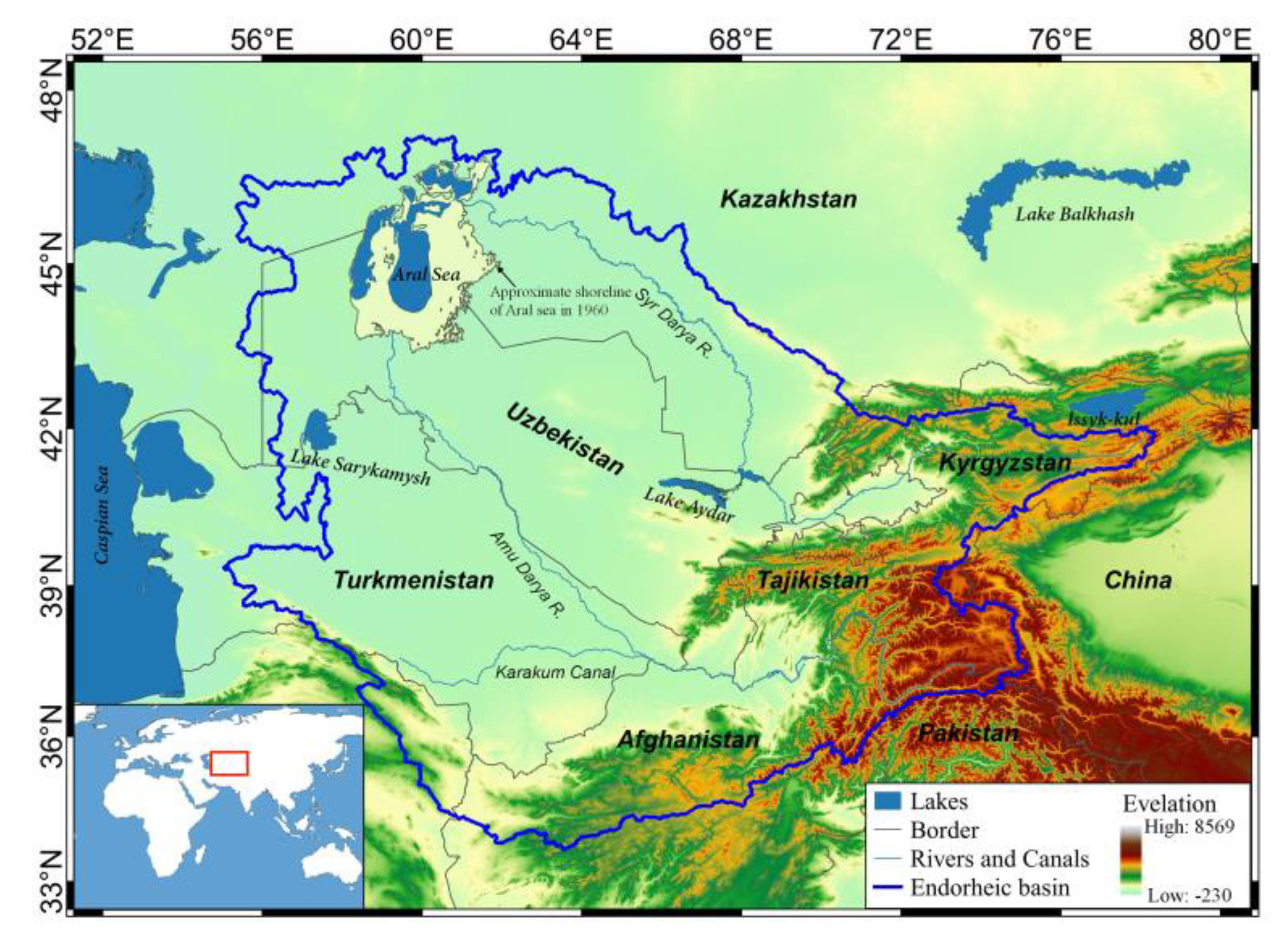

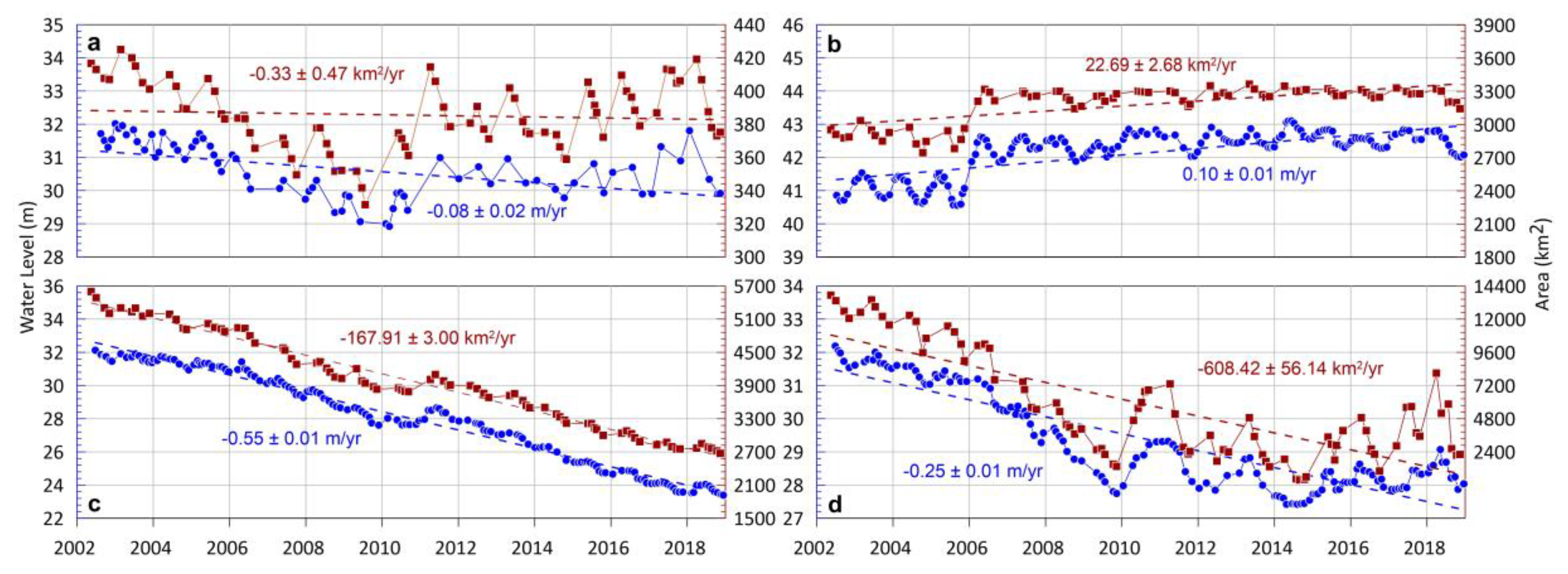
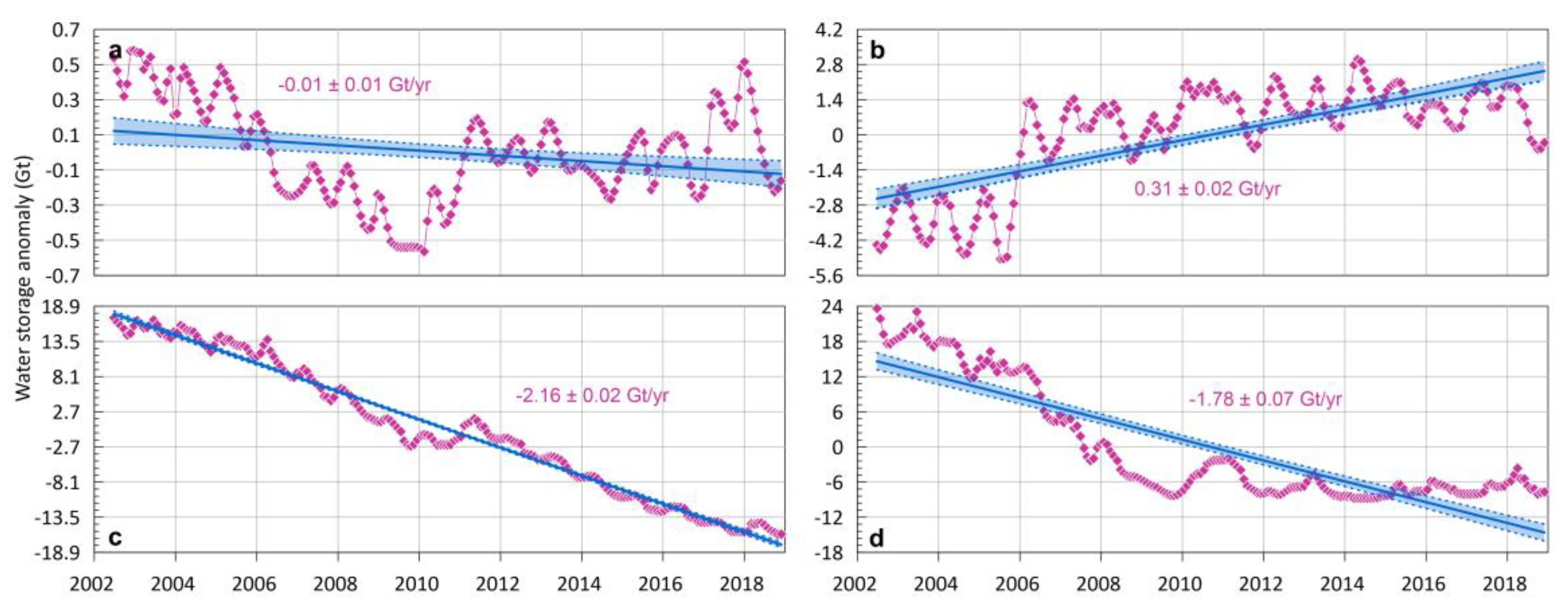
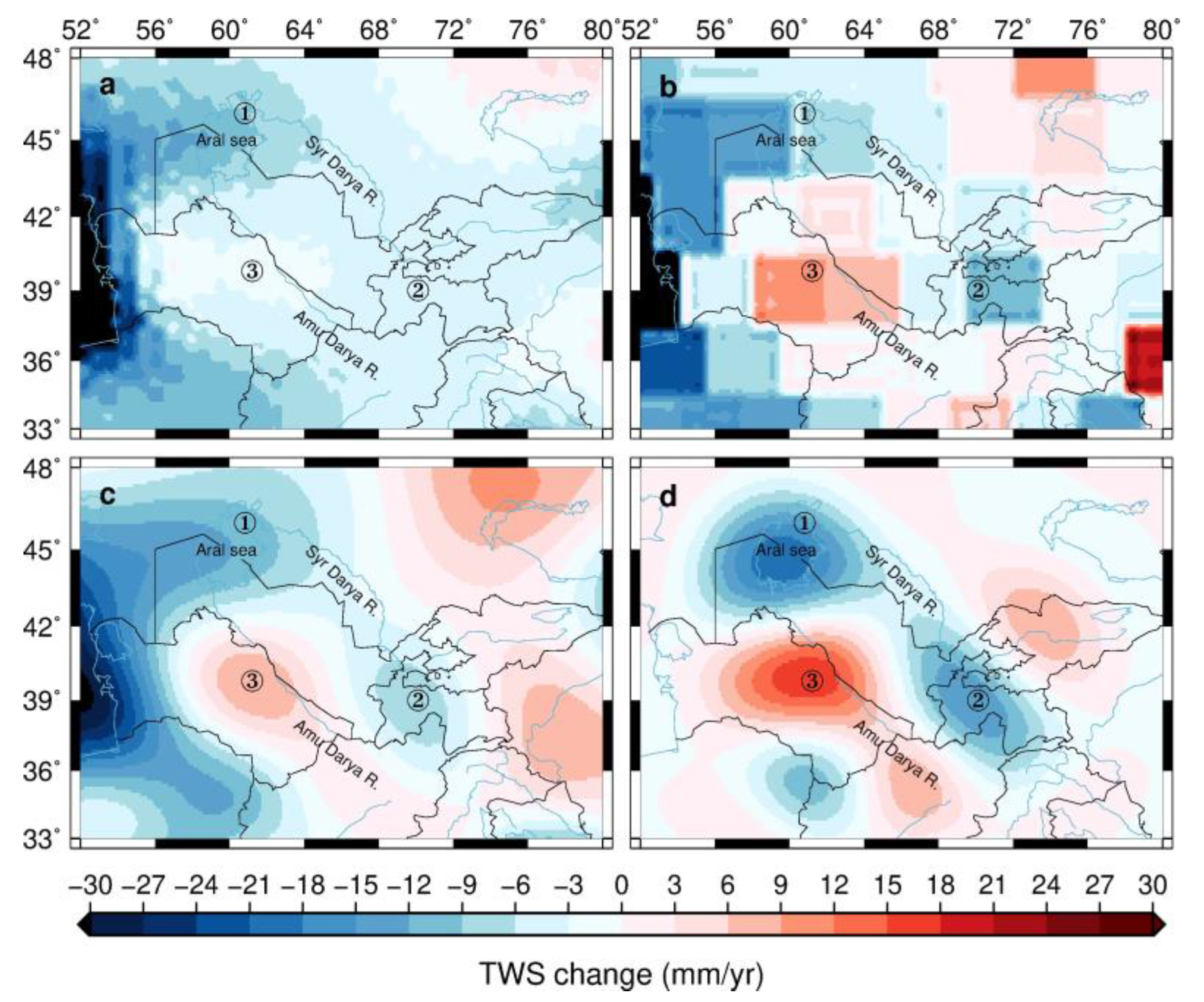
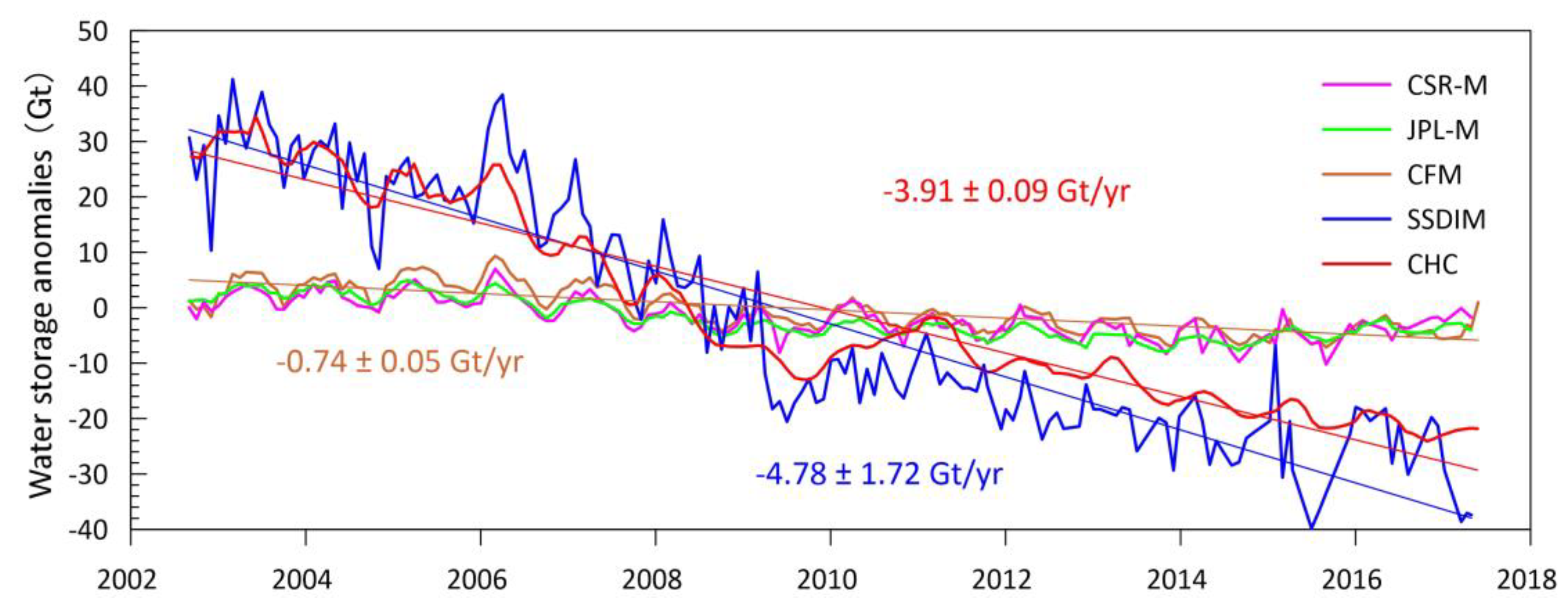
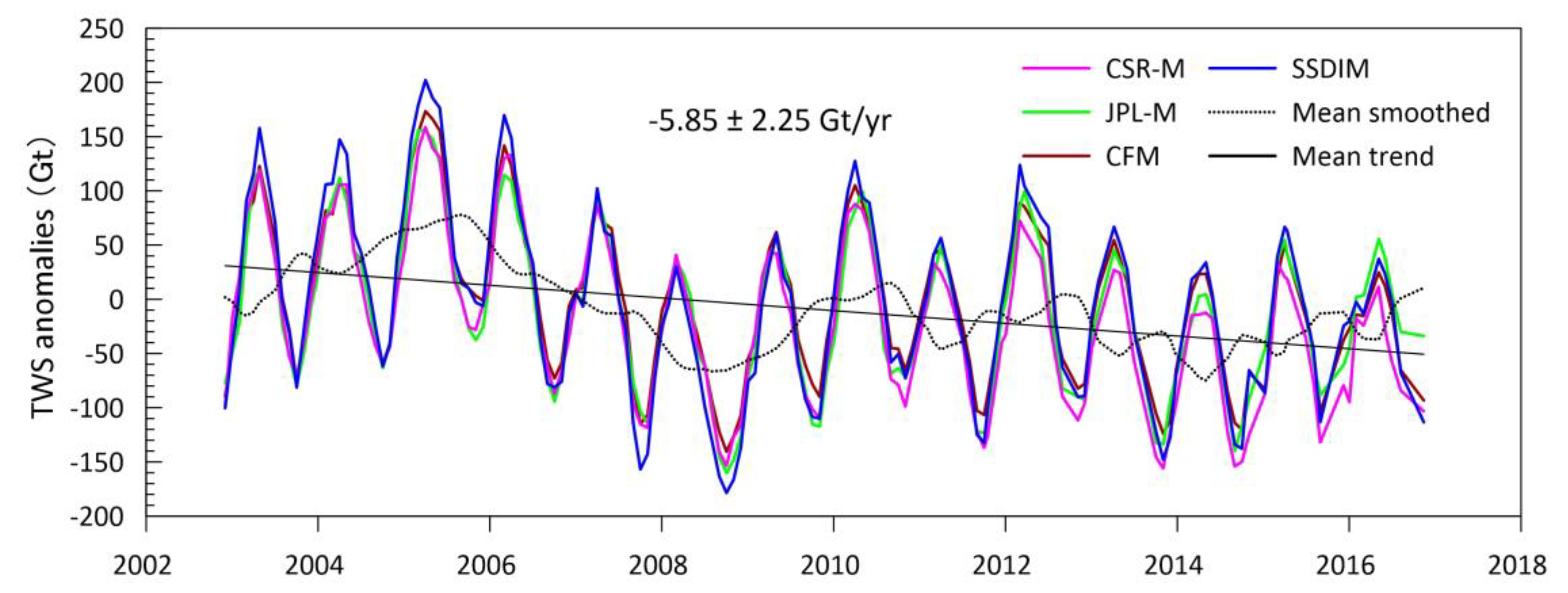
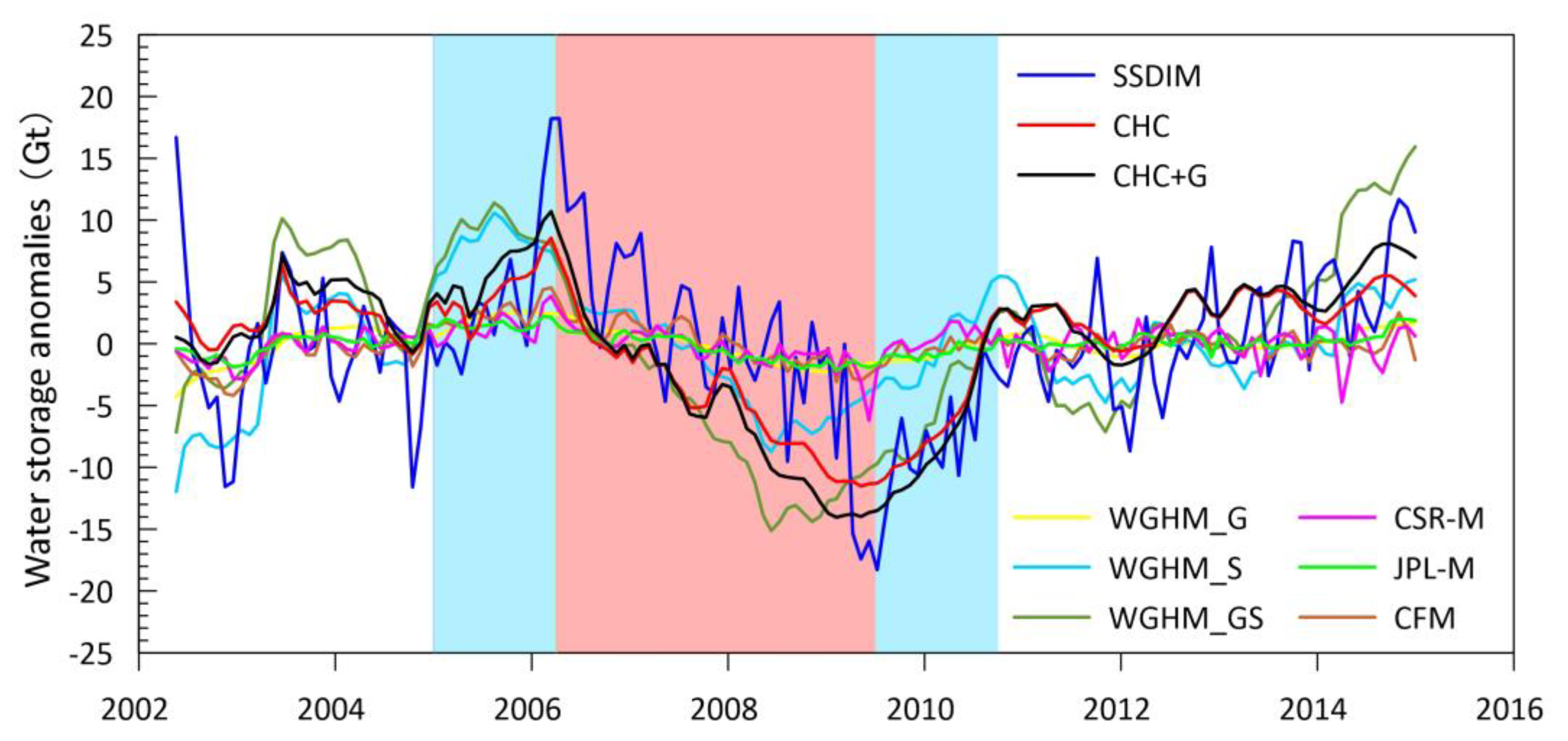
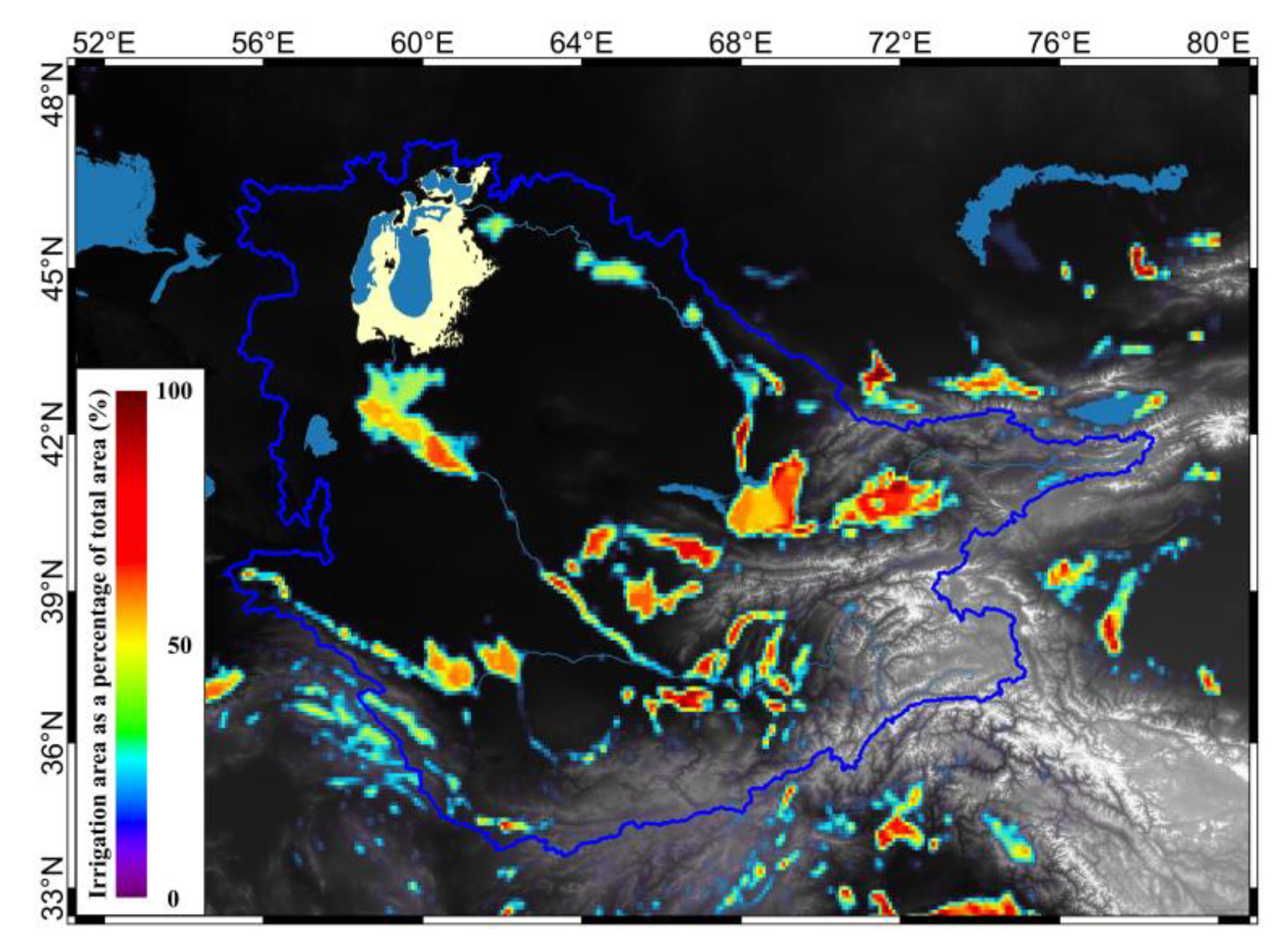
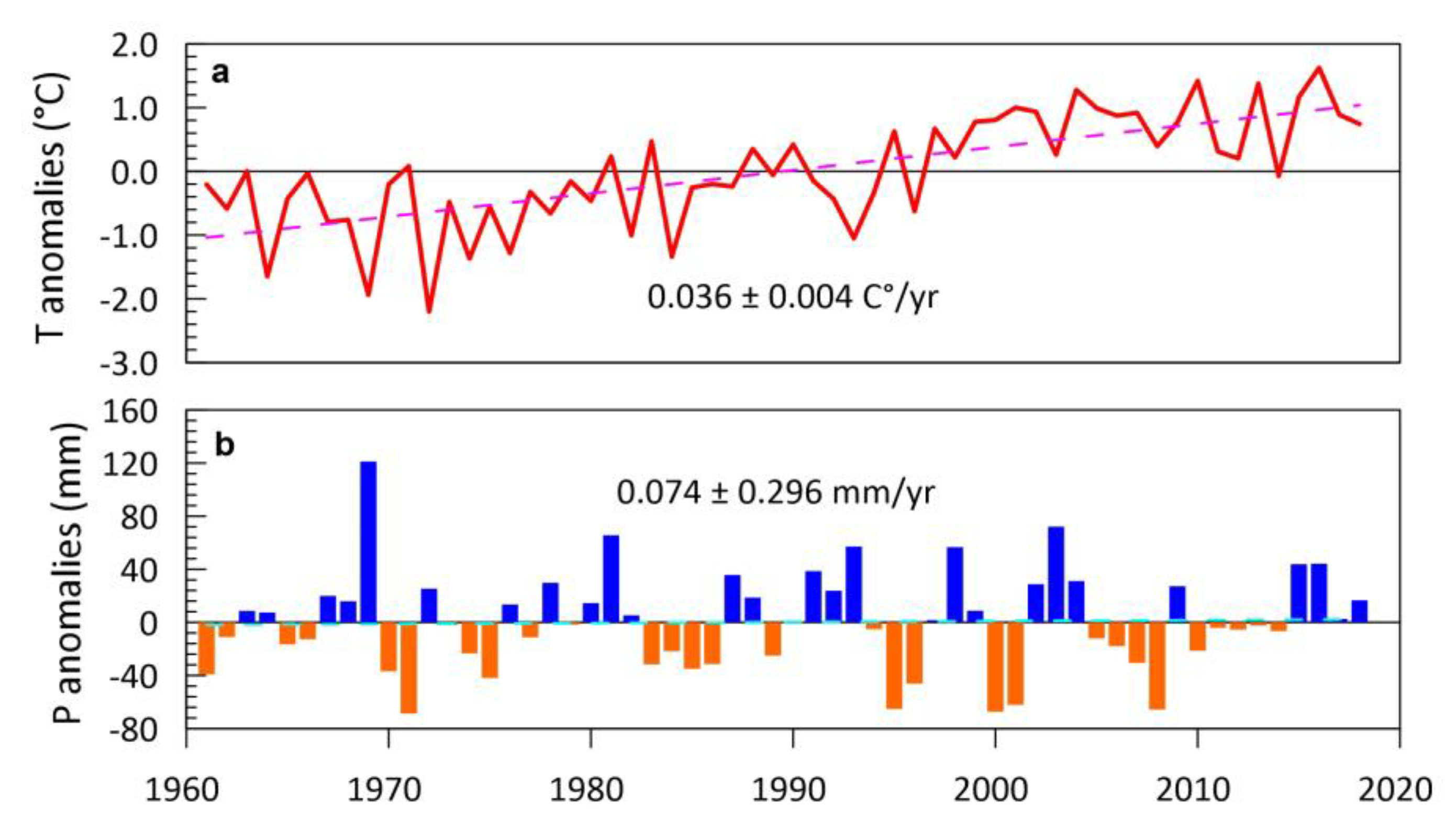

| Database | Type | Time Range | Source | Reference |
|---|---|---|---|---|
| DAHITI | Water level | 2002–2018 | Satellite altimetry | Schwatke et al. [16] |
| GRLM | Water level | 2002–2018 | Satellite altimetry | Birkett et al. [60] |
| Hydroweb NCEP/NCAR | Water level Temperature | 2002–2018 1960–2018 | Satellite altimetry Reanalysis dataset | Crétaux et al. [14] Kalnay et al. [61] |
| GHCN_CAMS CRU | Temperature Temperature | 1960–2018 1960–2018 | Based on gauge data Based on gauge data | Yun et al. [62] Harris et al. [63] |
| PREC/L | Precipitation | 1960–2018 | Based on gauge data | Chen et al. [64] |
| GPCC CRU | Precipitation Precipitation | 1960–2018 1960–2018 | Based on gauge data Based on gauge data | Schneider et al. [65] Harris et al. [63] |
| CFM | CSR-M | JPL-M | CHC | CHC+G | WGHM_G | WGHM_GS | ||||||||
|---|---|---|---|---|---|---|---|---|---|---|---|---|---|---|
| R | τ | R | τ | R | τ | R | τ | R | τ | R | τ | R | τ | |
| SSDIM | 0.64 ** | 0 | 0.42 ** | 0 | 0.58 ** | 0 | 0.64 ** | −2 | 0.65 ** | −2 | 0.59 ** | −1 | 0.60 ** | −1 |
| CFM | - | - | 0.68 ** | 0 | 0.79 ** | 0 | 0.43 ** | 0 | 0.49 ** | 0 | 0.74 ** | 1 | 0.52 ** | 1 |
| CSR-M | - | - | - | - | 0.62 ** | 0 | 0.37 * | 1 | 0.40 * | 1 | 0.53 ** | 0 | 0.40 * | −1 |
| JPL-M | - | - | - | - | - | - | 0.71 | 0 | 0.76 * | 0 | 0.82 ** | 0 | 0.79 ** | 0 |
| CHC | - | - | - | - | - | - | - | - | 0.99 ** | 0 | 0.63 * | 1 | 0.82 * | −1 |
| CHC+G | - | - | - | - | - | - | - | - | - | - | 0.71 * | 0 | 0.88 ** | −1 |
| WGHM_G | - | - | - | - | - | - | - | - | - | - | - | - | 0.80 ** | 0 |
© 2020 by the authors. Licensee MDPI, Basel, Switzerland. This article is an open access article distributed under the terms and conditions of the Creative Commons Attribution (CC BY) license (http://creativecommons.org/licenses/by/4.0/).
Share and Cite
Tao, D.; Shi, H.; Gao, C.; Zhan, J.; Ke, X. Water Storage Monitoring in the Aral Sea and its Endorheic Basin from Multisatellite Data and a Hydrological Model. Remote Sens. 2020, 12, 2408. https://doi.org/10.3390/rs12152408
Tao D, Shi H, Gao C, Zhan J, Ke X. Water Storage Monitoring in the Aral Sea and its Endorheic Basin from Multisatellite Data and a Hydrological Model. Remote Sensing. 2020; 12(15):2408. https://doi.org/10.3390/rs12152408
Chicago/Turabian StyleTao, Delong, Hongling Shi, Chunchun Gao, Jingang Zhan, and Xiaoping Ke. 2020. "Water Storage Monitoring in the Aral Sea and its Endorheic Basin from Multisatellite Data and a Hydrological Model" Remote Sensing 12, no. 15: 2408. https://doi.org/10.3390/rs12152408
APA StyleTao, D., Shi, H., Gao, C., Zhan, J., & Ke, X. (2020). Water Storage Monitoring in the Aral Sea and its Endorheic Basin from Multisatellite Data and a Hydrological Model. Remote Sensing, 12(15), 2408. https://doi.org/10.3390/rs12152408





